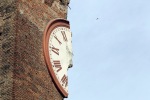Recently, I asked a friend of mine who lived in New York for a year what were some of the most interesting things she experienced while living in such a big city. I’ve heard her talk about a few things related to her experiences in New York, and also when she lived in Italy for a while, but I wanted to know specifically about something she found really unique about city life.
She mentioned that there were street artists everywhere, especially in Central Park, and it was very lively and entertaining. People-watching was fun, but some things could also be very weird and awkward. For example, she told me was about a time when she was sitting by herself at Central Park. She was drawing dresses in her sketchbook when a lady came up to her and started a conversation about her drawings. The lady told her she wrote children’s books and was dying to find an illustrator. Somehow these books dealt with fashion. So, my friend politely talked with her and exchanged email addresses, but when she received an email from the lady explaining whatever plans she had for the books, it made absolutely no sense. Convenient thing about New York is she never had much chance of running into that lady again, so the solution was super easy—the delete button. This is something I think I would really appreciate about being in a big city.
My friend also told me that the atmosphere in Rome, Italy was very similar to New York. People were always out and about, selling things, advertising things, doing street performances and all sorts of other fun things for passersby. I’ve never been to New York, so I only have a mental picture of what this would be like, and my imagination leans toward something like an eclectic version of Disney World. I really want to learn more about the different kinds of street artists and how they specifically contribute to the big city life picture.
I’m still learning and searching for more information, but I did stumble upon this particular article about street performers and “Quiet Zones”: http://culture.wnyc.org/articles/features/2011/may/30/street-performers-upset-central-park-quiet-zones/.
The article basically describes the interference of the enforcement of a new quiet zone with a man’s traditional music performances at the Bethesda Fountain and Strawberry Fields at Central Park every weekend.
Though I’m not sure if I would “side” with the musician, I want to understand his mentality more. It seems that small towns tend to get the reputation for being too traditional and set in their ways, but I really wonder about the city folks. Maybe city people don’t like change so much after all either, just in a different way. The city seems to make people feel entitled to freedom. Freedom of speech is a fundamental part of Boyd’s argument in the article, for example. Maybe what people want everywhere is really all the same, but it shows in different ways because our different cultural backgrounds shape us into having different values and sets of belief, which is something we sort of talked about in class.
People like to be able to do the things that they feel define themselves, whether they are city dwellers or not, and they want to do these things freely and comfortably, just as the lady at Central Park felt comfortable sharing her passion for children’s books with my friend.
In that regard, it just makes sense that the musician who is upset about the placement of quiet zones in his favorite stage location seems oddly similar to a farmer who is upset when his land taken away by the government for industrial expansion purposes. People just don’t like being bossed around, but maybe we just see that more clearly through situations which involve or in some way embody the city life for whatever reasons.


